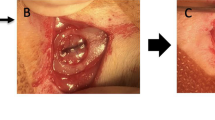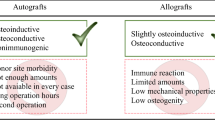Abstract
Glucocorticoid-induced osteonecrosis of the femoral head (SONFH) is the most prevalent form of secondary osteonecrosis affecting the femoral head. Glucocorticoids can cause damage to both vascular endothelial cells and osteoblasts. Previous studies have demonstrated that silicon can improve the resistance of vascular endothelial cells to oxidative stress and positively impact bone health. However, the impact of silicon on SONFH has yet to be investigated. We examined the influence of ortho-silicic acid (OSA, Si(OH)4) on the apoptosis and proliferation of vascular endothelial cells after glucocorticoid induction. Additionally, we evaluated the expression of apoptosis-related genes such as cleaved-caspase-3, Bcl-2 and Bax. The impact of glucocorticoids and OSA on the function of vascular endothelial cells was evaluated through wound healing, transwell and angiogenesis assays. Osteogenic function was subsequently evaluated through alizarin red staining, alkaline phosphatase staining and expression levels of osteogenic genes like RUNX2 and ALP. Moreover, we investigated the potential role of OSA in vivo using the SONFH animal model. At concentrations below 100 μM, OSA exhibits no toxicity on vascular endothelial cells and effectively reverses glucocorticoid-induced apoptosis in these cells. OSA increases the resilience of vascular endothelial cells against oxidative stress and enhances osteoblast differentiation. Our study revealed that glucocorticoids activate endoplasmic reticulum stress, a process that mediates the apoptosis of vascular endothelial cells. OSA ameliorated the endoplasmic reticulum stress associated with glucocorticoids through the increased expression of p-Akt levels. In vivo, OSA treatment effectively improved SONFH by enhancing vascular endothelial cell function and promoting osteogenic differentiation. OSA counteracted the adverse effects of glucocorticoids both in vitro and in vivo, demonstrating a beneficial therapeutic effect on SONFH.





Similar content being viewed by others
Data Availability
All data generated and analysed during this study are included in this published article and supplementary information file.
References
Lamb JN, Holton C, O’connor P et al (2019) Avascular necrosis of the hip. BMJ 365:l2178. https://doi.org/10.1136/bmj.l2178
Hardy RS et al (2018) Glucocorticoids and bone: consequences of endogenous and exogenous excess and replacement therapy. Endocr Rev 39(5):519–548
Buckley L, Humphrey MB (2018) Glucocorticoid-induced osteoporosis. N Engl J Med 379(26):2547–2556
Cui Q et al (2021) ARCO Consensus on the pathogenesis of non-traumatic osteonecrosis of the femoral head. J Korean Med Sci 36(10):e65
Houdek MT et al (2016) Decreased osteogenic activity of mesenchymal stem cells in patients with corticosteroid-induced osteonecrosis of the femoral head. J Arthroplasty 31(4):893–898
Carlisle EM (1970) Silicon: a possible factor in bone calcification. Science 167(3916):279–280
Jugdaohsingh R et al (2002) Dietary silicon intake and absorption. Am J Clin Nutr 75(5):887–893
Rondanelli M et al (2021) Silicon: a neglected micronutrient essential for bone health. Exp Biol Med (Maywood) 246(13):1500–1511
You Y et al (2021) Ortho-silicic acid enhances osteogenesis of osteoblasts through the upregulation of miR-130b which directly targets PTEN. Life Sci 264:118680
Monte F et al (2018) Ionic silicon improves endothelial cells’ survival under toxic oxidative stress by overexpressing angiogenic markers and antioxidant enzymes. J Tissue Eng Regen Med 12(11):2203–2220
Ding Z et al (2017) Si-doped porous TiO(2) coatings enhanced in vitro angiogenic behavior of human umbilical vein endothelial cells. Colloids Surf B Biointerfaces 159:493–500
Guo C et al (2016) Amorphous silica nanoparticles trigger vascular endothelial cell injury through apoptosis and autophagy via reactive oxygen species-mediated MAPK/Bcl-2 and PI3K/Akt/mTOR signaling. Int J Nanomedicine 11:5257–5276
Lee KI et al (2020) Ultrafine silicon dioxide nanoparticles cause lung epithelial cells apoptosis via oxidative stress-activated PI3K/Akt-mediated mitochondria- and endoplasmic reticulum stress-dependent signaling pathways. Sci Rep 10(1):9928
Kong Y et al (2022) Silicon-substituted calcium phosphate promotes osteogenic-angiogenic coupling by activating the TLR4/PI3K/AKT signaling axis. J Biomater Appl 37(3):459–473
Rapoport TA (2007) Protein translocation across the eukaryotic endoplasmic reticulum and bacterial plasma membranes. Nature 450(7170):663–669
Wang M, Kaufman RJ (2016) Protein misfolding in the endoplasmic reticulum as a conduit to human disease. Nature 529(7586):326–335
Song X et al (2017) Dioscin induces gallbladder cancer apoptosis by inhibiting ROS-mediated PI3K/AKT signalling. Int J Biol Sci 13(6):782–793
Zhang J et al (2022) MPST deficiency promotes intestinal epithelial cell apoptosis and aggravates inflammatory bowel disease via AKT. Redox Biol 56:102469
Liao Z et al (2019) Exosomes from mesenchymal stem cells modulate endoplasmic reticulum stress to protect against nucleus pulposus cell death and ameliorate intervertebral disc degeneration in vivo. Theranostics 9(14):4084–4100
Tao SC et al (2017) Exosomes derived from human platelet-rich plasma prevent apoptosis induced by glucocorticoid-associated endoplasmic reticulum stress in rat osteonecrosis of the femoral head via the Akt/Bad/Bcl-2 signal pathway. Theranostics 7(3):733–750
Zhang X et al (2021) Ischemia-induced upregulation of autophagy preludes dysfunctional lysosomal storage and associated synaptic impairments in neurons. Autophagy 17(6):1519–1542
Jugdaohsingh R et al (2013) The silicon supplement “monomethylsilanetriol” is safe and increases the body pool of silicon in healthy pre-menopausal women. Nutr Metab (Lond) 10(1):37
Gu G et al (2023) Ortho-silicic acid plays a protective role in glucocorticoid-induced osteoporosis via the Akt/Bad Signal pathway in vitro and in vivo. Biol Trace Elem Res 201(2):843–855
Partridge L, Deelen J, Slagboom PE (2018) Facing up to the global challenges of ageing. Nature 561(7721):45–56
Cui L et al (2016) Multicentric epidemiologic study on six thousand three hundred and ninety five cases of femoral head osteonecrosis in China. Int Orthop 40(2):267–276
Hu K, Olsen BR (2016) Osteoblast-derived VEGF regulates osteoblast differentiation and bone formation during bone repair. J Clin Invest 126(2):509–526
Dong M et al (2016) Biological silicon stimulates collagen type 1 and osteocalcin synthesis in human osteoblast-like cells through the BMP-2/Smad/RUNX2 signaling pathway. Biol Trace Elem Res 173(2):306–315
Magnusson C et al (2021) Inhibitory effects of orthosilicic acid on osteoclastogenesis in RANKL-stimulated RAW264.7 cells. J Biomed Mater Res A 109(10):1967–1978
Li Z et al (2021) Graphene oxide-functionalized nanocomposites promote osteogenesis of human mesenchymal stem cells via enhancement of BMP-SMAD1/5 signaling pathway. Biomaterials 277:121082
Anelli T, Sitia R (2008) Protein quality control in the early secretory pathway. Embo j 27(2):315–327
Ramírez S et al (2017) Mitochondrial dynamics mediated by mitofusin 1 is required for POMC neuron glucose-sensing and insulin release control. Cell Metab 25(6):1390-1399.e6
van Anken E et al (2009) Efficient IgM assembly and secretion require the plasma cell induced endoplasmic reticulum protein pERp1. Proc Natl Acad Sci U S A 106(40):17019–17024
Hitomi J et al (2004) Involvement of caspase-4 in endoplasmic reticulum stress-induced apoptosis and Abeta-induced cell death. J Cell Biol 165(3):347–356
Szegezdi E, Fitzgerald U, Samali A (2003) Caspase-12 and ER-stress-mediated apoptosis: the story so far. Ann N Y Acad Sci 1010:186–194
Szegezdi E et al (2006) Mediators of endoplasmic reticulum stress-induced apoptosis. EMBO Rep 7(9):880–885
Brewer JW, Diehl JA (2000) PERK mediates cell-cycle exit during the mammalian unfolded protein response. Proc Natl Acad Sci U S A 97(23):12625–12630
Liang G et al (2008) Polycystin-2 down-regulates cell proliferation via promoting PERK-dependent phosphorylation of eIF2alpha. Hum Mol Genet 17(20):3254–3262
Oakes SA, Papa FR (2015) The role of endoplasmic reticulum stress in human pathology. Annu Rev Pathol 10:173–194
McCullough KD et al (2001) Gadd153 sensitizes cells to endoplasmic reticulum stress by down-regulating Bcl2 and perturbing the cellular redox state. Mol Cell Biol 21(4):1249–1259
Ubeda M et al (1996) Stress-induced binding of the transcriptional factor CHOP to a novel DNA control element. Mol Cell Biol 16(4):1479–1489
Cao SS, Kaufman RJ (2014) Endoplasmic reticulum stress and oxidative stress in cell fate decision and human disease. Antioxid Redox Signal 21(3):396–413
Hou Y et al (2019) BDE-209 induces autophagy and apoptosis via IRE1α/Akt/mTOR signaling pathway in human umbilical vein endothelial cells. Environ Pollut 253:429–438
Revathidevi S, Munirajan AK (2019) Akt in cancer: mediator and more. Semin Cancer Biol 59:80–91
Abeyrathna P, Su Y (2015) The critical role of Akt in cardiovascular function. Vascul Pharmacol 74:38–48
He Q et al (2021) Synergistic stimulation of osteoblast differentiation of rat mesenchymal stem cells by leptin and 25(OH)D(3) is mediated by inhibition of chaperone-mediated autophagy. Stem Cell Res Ther 12(1):557
Wang N et al (2021) Berberine improves insulin-induced diabetic retinopathy through exclusively suppressing Akt/mTOR-mediated HIF-1α/VEGF activation in retina endothelial cells. Int J Biol Sci 17(15):4316–4326
Nogueira V et al (2008) Akt determines replicative senescence and oxidative or oncogenic premature senescence and sensitizes cells to oxidative apoptosis. Cancer Cell 14(6):458–470
Acknowledgements
We thank the Translational Medicine Core Facility of Shandong University, Laboratory of Basic Medical Sciences of Qilu Hospital of Shandong University, School of Basic Medical Sciences, Shandong University, for consultation and instrument availability that supported this work.
Funding
This work was supported by the Natural Science Foundation of Shandong Province (ZR2020QH080).
Author information
Authors and Affiliations
Contributions
ZS contributed to the conceptualisation, methodology and original draft writing. JW and ZJ carried out the data analysis and review, editing and writing of the manuscript. ZS and JW participated in the formal analysis and software. JM contributed to the visualisation and investigation. ZJ contributed to the resources and validation. YC contributed to the supervision. GJ was responsible for the project administration and funding acquisition. All authors read and approved the final manuscript.
Corresponding authors
Ethics declarations
Ethics Approval and Consent to Participate
This study was approved by the Medical Ethics Committee of Qilu Hospital of Shandong University. All animal studies complied with the principles based on the International Guiding Principles for Biomedical Research Involving Animals.
Consent for Publication
Informed consent was obtained from all subjects involved in the study.
Competing Interests
The authors declare no competing interests.
Additional information
Publisher's Note
Springer Nature remains neutral with regard to jurisdictional claims in published maps and institutional affiliations.
Rights and permissions
Springer Nature or its licensor (e.g. a society or other partner) holds exclusive rights to this article under a publishing agreement with the author(s) or other rightsholder(s); author self-archiving of the accepted manuscript version of this article is solely governed by the terms of such publishing agreement and applicable law.
About this article
Cite this article
Sun, Z., Wang, J., Ji, Z. et al. Ortho-silicic Acid Prevents Glucocorticoid-Induced Femoral Head Necrosis by Promoting Akt Phosphorylation to Inhibit Endoplasmic Reticulum Stress-Mediated Apoptosis and Enhance Angiogenesis and Osteogenesis. Biol Trace Elem Res (2024). https://doi.org/10.1007/s12011-023-04048-6
Received:
Accepted:
Published:
DOI: https://doi.org/10.1007/s12011-023-04048-6




